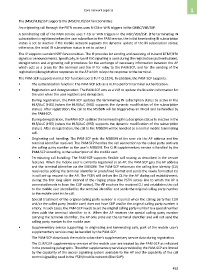Page 463 - 5G Basics - Core Network Aspects
P. 463
Core network aspects 1
The (MSC/VLR)/SSP supports the (MSC/VLR)/SSF functionalities.
An originating call through the PSTN access uses N-CSI or WIN triggers in the GMSC/VLR/SSP.
A terminating call of the PAM service uses T-CSI or WIN triggers in the MSC/VLR/SSP. (The terminating IN
subscription is registered when the user subscribes to the PAM service, the initial terminating IN subscription
status is set to inactive if the mobile network supports the dynamic update of the IN subscription status;
otherwise, the initial IN subscription status is set to active.)
The IP supports standard SRF functionalities. The IP provides for sending and receiving of in-band DTMF/FSK
signals or announcements. Specifically, in-band FSK signalling is used during the registration (authentication),
deregistration and originating call procedures for the exchange of necessary information between the AP
which acts as a proxy for the terminal and the IP for relay to the PAM-SCP, and for the sending of the
registration/deregistration responses to the AP which relays the response to the terminal.
The PAM-SCP supports normal SCF functions per [ITU-T Q.1224]. In addition, the PAM-SCP supports:
• The authentication function: The PAM-SCP acts as a VLR to perform terminal authentication.
• Registration and deregistration: The PAM-SCP acts as a VLR to update the location information for
the user when the user registers and deregisters.
During registration, the PAM-SCP updates the terminating IN subscription status to active in the
HLR/AuC (HSS) (when the HLR/AuC (HSS) supports the dynamic modification of the subscription
status). After registration, the call to the MSISDN will be triggered as an IN call and be handled by
the PAM-SCP.
During deregistration, the PAM-SCP updates the terminating IN subscription status to inactive in the
HLR/AuC (HSS) (when the HLR/AuC (HSS) supports the dynamic modification of the subscription
status). After deregistration, the call to the MSISDN will be handled as a normal mobile terminating
call.
• Originating call handling: The PAM-SCP gets the MSISDN of the user via the AP address and the
terminal identifier received. The PAM-SCP handles the call connection to the called party and sets
the calling party number as the user's MSISDN. The CLIR supplementary service is handled by the
PAM-SCP according to the subscription of the mobile user.
• Terminating call handling: The PAM-SCP supports flexible call routing as described in the service
features. When the mobile user is currently registered at an AP, the PAM-SCP gets the AP address
and the terminal identifier via the MSISDN. The PAM-SCP reformats the calling line identity (CLI)
received by adding the terminal identifier in predefined format and sends the newly formatted CLI
in call set-up request to the AP. The PSTN will deliver the CLI to the AP during call establishment,
during the first long silent interval of the ringing phase (the PSTN access line to which the AP is
connected needs to have the CLIP active). The AP resolves the received CLI and establishes the call
to the mobile user identified by the terminal identifier and sends the original calling party number
to the mobile user in the call.
Special treatment of the original calling party number is required when the calling party has CLIR
and/or the called party (mobile user) does not have CLIP and/or the original calling party number is
empty. In such cases, the PAM-SCP needs to set the original calling party number to a special number
then adds the terminal identifier to it. When the AP receives the special calling party number
carrying the terminal identifier, the AP only picks out the terminal identifier and will not send the
calling party number to the mobile user.
• Supplementary service supporting: In originating and terminating calls, part of the mobile user's
supplementary services may be handled by the PAM-SCP.
The PAM-SCP downloads the mobile subscriber's supplementary service data during registration.
The CLIP/CLIR supplementary services of the mobile user are treated by the PAM-SCP as indicated
in the preceding paragraphs. The other supplementary services provided by the PAM-SCP are limited
by the capability of the access signalling system available to the AP and the capability of the call
control signalling used in the PSTN/mobile network (like ISUP).
453

